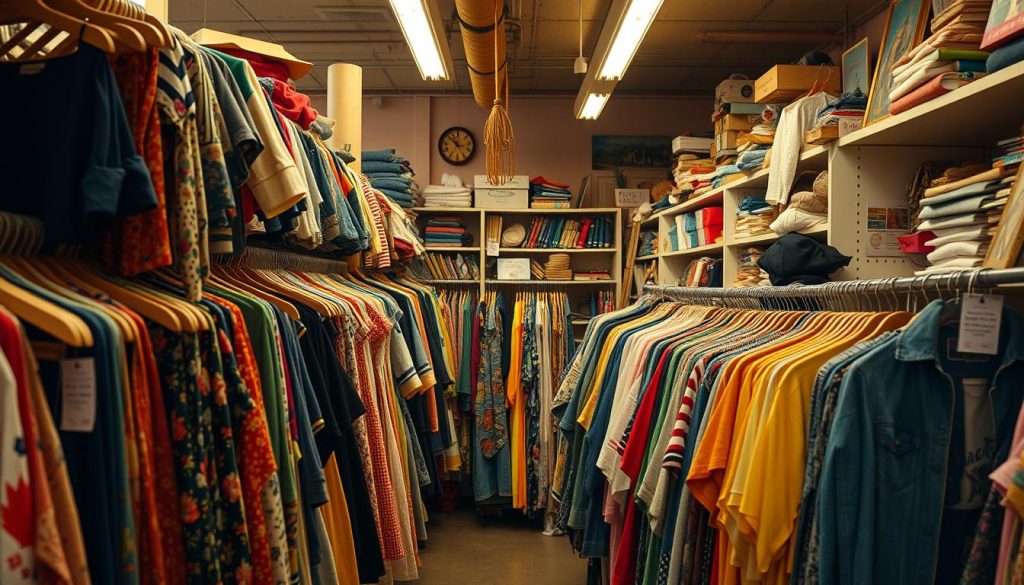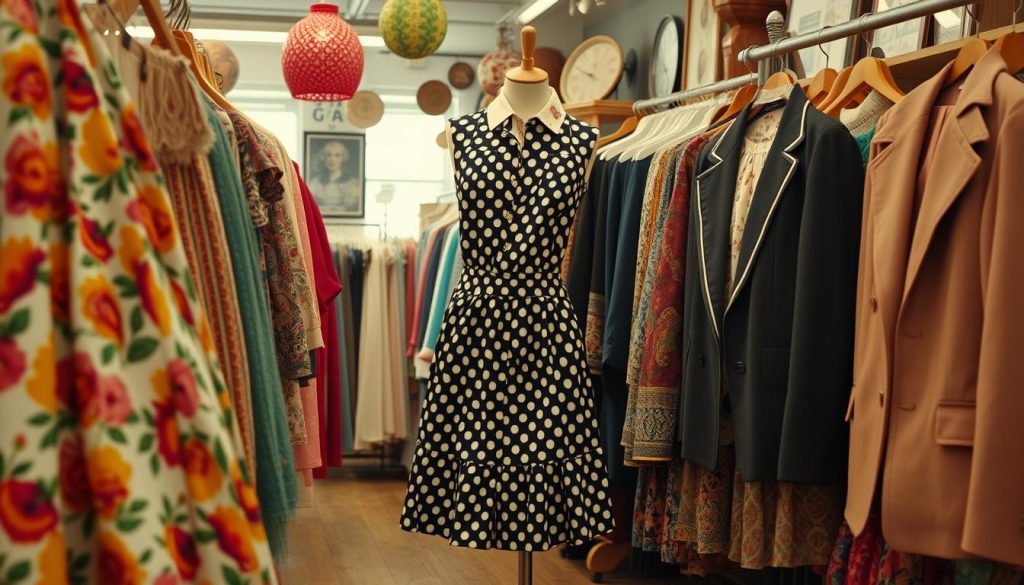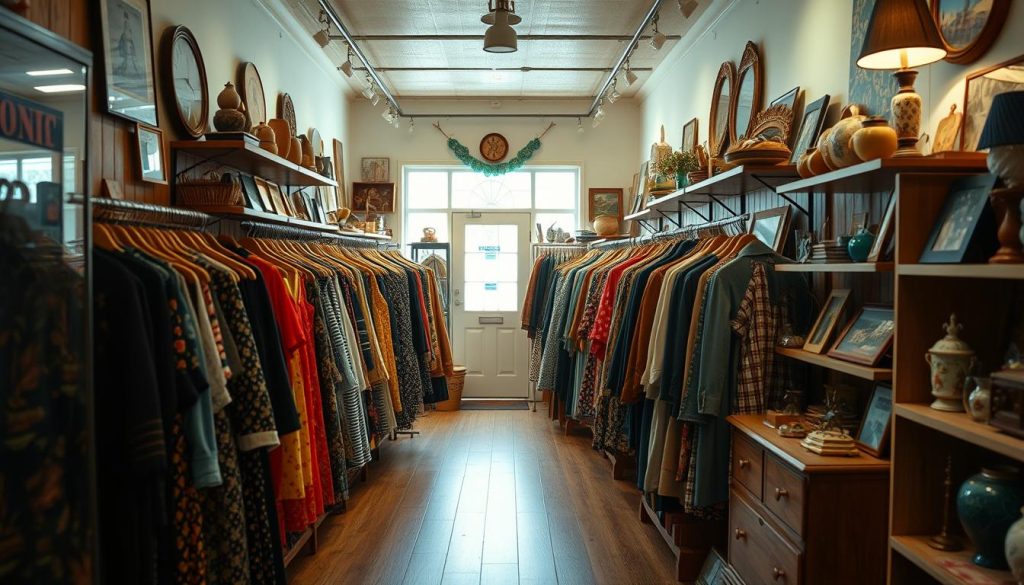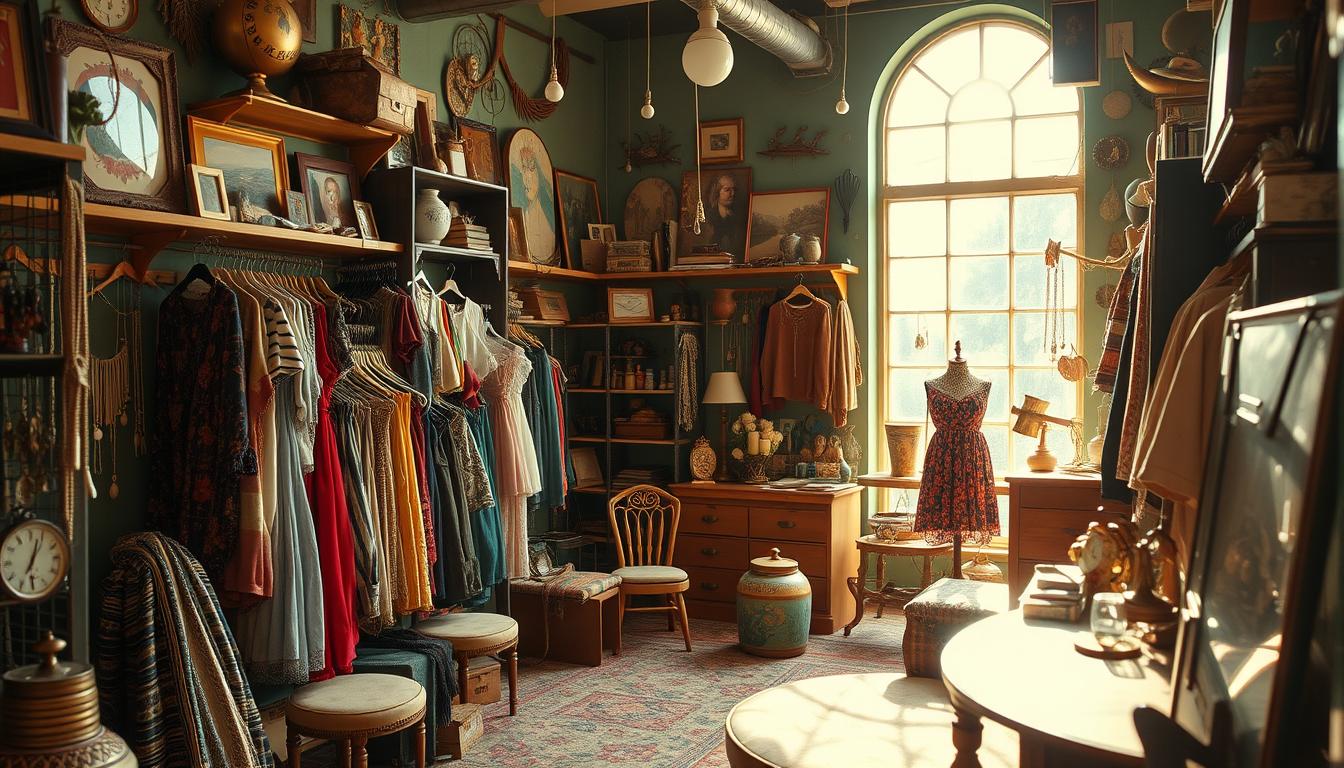I love the excitement of finding hidden treasures in secondhand shops. Every item has a story to tell. You can find everything from vintage clothes to unique preloved items.
Thrift stores are my favorite places to find great deals. I save money and help the environment by choosing secondhand. It’s a win-win that makes me feel good.
In this article, we’ll explore the world of secondhand shopping together. We’ll look at local shops and online platforms. I’ll share tips to help you find amazing deals. Get ready to discover treasures that others have loved!
The Art of Treasure Hunting: Mastering Secondhand Shopping
I love the thrill of finding treasures in secondhand shops. It’s an art that needs practice, patience, and a sharp eye. At first, I felt lost among all the items. But now, I can spot hidden gems easily.
My approach to successful thrifting begins with research. I watch fashion trends and designer brands. This helps me find valuable items that others miss. I also plan my visits when stores restock.
It’s important to know the quality of items in secondhand shops. I check the fabric, stitching, and condition. A simple fix can turn a cheap find into a must-have.
- Research current trends and designer brands
- Plan visits on restock days
- Examine fabric and stitching quality
- Look for items with potential for upcycling
Finding great deals is one of the best parts of treasure hunting. I’ve scored designer labels for a fraction of their price. Vintage pieces that are back in style are especially exciting, offering unique and affordable fashion.
| Item | Retail Price | Thrift Store Price | Savings |
|---|---|---|---|
| Designer Jeans | $200 | $25 | 87.5% |
| Vintage Leather Jacket | $300 | $40 | 86.7% |
| Brand Name Shoes | $150 | $20 | 86.7% |
The secret to mastering secondhand shopping is to keep trying. Not every trip will be a success, but the good finds make it all worth it. Happy hunting for those thrifty finds and hidden gems!
Thrift Stores: Your Gateway to Affordable Fashion

Thrift stores are a treasure trove for those who love affordable fashion. With patience and a keen eye, you can find amazing deals on designer labels and unique pieces. Let’s explore the world of thrifting and learn how to shop smart.
Navigating the Aisles: Tips for Successful Thrifting
When I enter a thrift store, I look for quality fabrics and well-made clothes. Touching the clothes helps me spot potential gems. Here are some tips to make your thrifting better:
- Shop on weekdays for fewer crowds
- Check for weekly sales or discount days
- Bring a portable steamer to remove wrinkles
- Wear form-fitting clothes for easy try-ons
Hidden Gems: Spotting Designer Labels at Thrift Stores
Finding designer labels at thrift stores is like winning a jackpot. Look for quality stitching, unique buttons, and luxurious fabrics. Always check the label carefully, as designer pieces can be hidden among regular items.
Thrift Store Etiquette: Do’s and Don’ts
Good etiquette makes shopping at thrift stores enjoyable for everyone. Here’s a quick guide to thrift store manners:
| Do’s | Don’ts |
|---|---|
| Return items to their proper place | Leave clothes on the floor |
| Be patient while waiting for fitting rooms | Hog the mirror or fitting room |
| Respect store policies on returns | Argue with staff about prices |
| Bring your own reusable bags | Leave a mess in the dressing room |
By following these tips and guidelines, you’ll become a pro at thrift store shopping. You’ll find incredible affordable fashion finds.
Vintage Clothing: Embracing Timeless Style

Vintage clothing is a mix of timeless style and sustainable fashion. I enjoy searching thrift stores and antique shops for unique pieces. These items add character to my wardrobe and help reduce fashion waste.
When I shop for vintage, I look for quality materials and craftsmanship. Real vintage items often have hand-sewn labels, metal zippers, and strong fabrics. To keep these items in good shape, I clean them gently and store them carefully.
Mixing vintage with modern outfits is an art. I pair a 1950s blouse with today’s jeans or add vintage jewelry to a modern dress. This way, I create a unique look that’s different from mass-produced fashion.
| Decade | Iconic Style | Key Pieces |
|---|---|---|
| 1950s | Feminine silhouettes | Full skirts, fitted blouses |
| 1960s | Mod fashion | Mini skirts, bold prints |
| 1970s | Bohemian chic | Flared pants, maxi dresses |
Choosing vintage clothing means I’m not just loving timeless style; I’m also helping the planet. Every vintage piece I find is one less item in a landfill. So, vintage shopping is good for both my wardrobe and the environment.
Consignment Shops: Quality Finds at Fraction of the Cost

I love finding amazing deals at consignment shops. These stores let you score designer items and trendy pieces without spending a lot. Let’s explore how consignment works and how you can benefit from it.
Understanding Consignment: How It Works
Consignment shops are different from regular thrift stores. When you sell items on consignment, you still own them until they sell. The shop displays and markets your goods, taking a cut of the sale price as commission.
This setup is good for both sides. Sellers get to make money, and buyers find great deals.
Best Practices for Selling Your Items on Consignment
To sell items successfully, follow these tips:
- Clean and prepare your items before bringing them in
- Research current trends and pricing
- Choose high-quality, gently-used pieces
- Be realistic about pricing expectations
Negotiating at Consignment Shops: Getting the Best Deals
As a buyer, don’t hesitate to negotiate prices. Many shops are open to negotiations, especially for items that have been there for a while. Always ask if there’s room for price adjustment, and you might get an even better deal.
| Selling Items | Buying Items |
|---|---|
| Clean and prepare goods | Research prices beforehand |
| Price items competitively | Inspect items carefully |
| Choose in-demand pieces | Negotiate politely |
| Check store policies | Visit regularly for best selection |
Flea Markets: A Treasure Trove of Unique Items
I love exploring flea markets. These places are full of unique items waiting to be found. You can find everything from vintage clothes to antique furniture here.
To find the best deals, arrive early. The best items sell out fast. Bring cash, as many sellers don’t take cards. And don’t forget to wear comfy shoes, as you’ll be doing a lot of walking.
When I see something I like, I check it carefully. Flea markets are full of hidden gems. But, it’s key to look for any damage or repairs. If you’re not sure about an item’s value, ask the seller about its history.
Haggling is a big part of flea market fun. I start by offering 50-60% of the asking price. Being polite and friendly helps a lot. And if a price seems too high, it’s okay to walk away.
Flea markets are also great for finding unique collectibles. I’ve found rare vinyl records, vintage cameras, and antique jewelry here. Keep an eye out for unusual items that catch your eye – you might find something amazing!
With patience and a keen eye, you can find amazing deals at flea markets. Happy hunting!
Garage Sales: Neighborhood Gems Await
Garage sales are a great way to find hidden treasures at low prices. I’ve discovered many unique items, from old furniture to rare collectibles. Let’s dive into how to make the most of these local events.
Planning Your Route: Maximizing Your Garage Sale Experience
To get the most out of garage sales, I plan my route carefully. I look up local listings and map out a path. This way, I can visit many sales quickly, finding amazing deals.
- Check online classifieds and community boards
- Use garage sale apps to find nearby sales
- Start early for the best selection
- Bring small bills and change for easy transactions
Haggling 101: How to Negotiate at Garage Sales
Haggling is key to scoring at garage sales. Being polite and respectful helps a lot. Start by asking if the price is set, then offer a fair price. The goal is to find a price that both sides agree on.
Unexpected Finds: Stories of Garage Sale Jackpots
I’ve heard amazing stories of garage sale finds. One friend found a rare book for $1, worth thousands. Another found a vintage guitar worth a lot. These stories motivate me to keep searching for treasures in my neighborhood.
| Item | Purchase Price | Actual Value |
|---|---|---|
| Antique Vase | $5 | $500 |
| Vintage Watch | $20 | $1,200 |
| Comic Book Collection | $50 | $3,000 |
Upcycling: Breathing New Life into Preloved Items
I love giving old things a fresh start. Upcycling lets me turn preloved items into exciting new treasures. It’s a fun way to be creative and eco-friendly at the same time.
When I spot a worn-out piece of furniture or outdated decor, I see potential. With some imagination and elbow grease, these items can become unique statement pieces. Painting, reupholstering, or repurposing are just a few ways to breathe new life into old stuff.
DIY projects are at the heart of upcycling. I’ve turned old ladders into bookshelves and vintage suitcases into side tables. The possibilities are endless! Here are some popular upcycling techniques I use:
- Chalk painting furniture
- Decoupage for decorative effects
- Repurposing items for new functions
- Adding modern hardware to dated pieces
To get started with upcycling, keep an eye out for items with good bones but tired looks. Yard sales and thrift stores are goldmines for potential projects. Basic DIY skills like painting, sanding, and simple repairs go a long way in transforming preloved items.
| Item | Upcycling Idea | Skill Level |
|---|---|---|
| Old dresser | Paint and add new knobs | Beginner |
| Wooden pallet | Create outdoor furniture | Intermediate |
| Wine bottles | Make decorative vases | Beginner |
| Vintage suitcase | Transform into a pet bed | Intermediate |
Upcycling is more than a hobby – it’s a way to reduce waste and express creativity. By giving preloved items a second chance, I’m doing my part for the planet while creating one-of-a-kind pieces for my home.
Sustainable Fashion: The Environmental Impact of Secondhand Shopping
I love sustainable fashion and how it helps our planet. Shopping secondhand saves money and makes a big difference. Let’s explore the good things about buying preloved items.
Secondhand shopping cuts down on waste. It gives clothes a new life, keeping them out of landfills. The average American throws away 81 pounds of clothes yearly. By choosing secondhand, we can greatly reduce this number.
Buying used also saves resources. Making new clothes uses water, energy, and raw materials. When I pick secondhand, I help save these resources. It’s a simple way to reduce my carbon footprint and support sustainable fashion.
- Reduces textile waste in landfills
- Conserves water and energy
- Lowers demand for new production
- Decreases pollution from manufacturing
The impact of our fashion choices is huge. By choosing secondhand, we fight against fast fashion’s harm. It’s a simple way to make our wardrobes greener without losing style.
| Action | Environmental Benefit |
|---|---|
| Buying 1 used item | Saves 6 lbs of CO2 emissions |
| Thrifting for a year | Saves 700 lbs of CO2 emissions |
| Extending clothing life by 9 months | Reduces carbon and water footprints by 20-30% |
By choosing secondhand, we’re part of a big change. Every preloved item we pick helps make our future greener. So, next time you shop, remember the power of your choices. Your wallet and the planet will appreciate it!
Online Platforms: Expanding Your Secondhand Shopping Horizons
Online platforms have changed the game for secondhand shopping. Sites like eBay, Poshmark, and ThredUP bring a world of pre-loved items to your screen. You can browse, compare prices, and find unique items from home.
When shopping online, I check seller ratings and read item descriptions. Clear photos help me see the condition. But I also ask for more details. Some sites even protect buyers, making me feel secure.
While online shopping is convenient, nothing beats the thrill of in-person thrifting. Online, I miss the touch and surprise of finding something special. Yet, e-commerce lets me explore vintage and designer items from anywhere.
Whether browsing online or in stores, secondhand shopping is a win-win. It helps me build a unique wardrobe while saving money and the planet. It’s a joy I keep coming back to!

